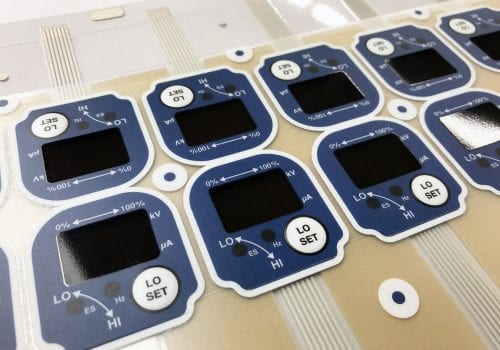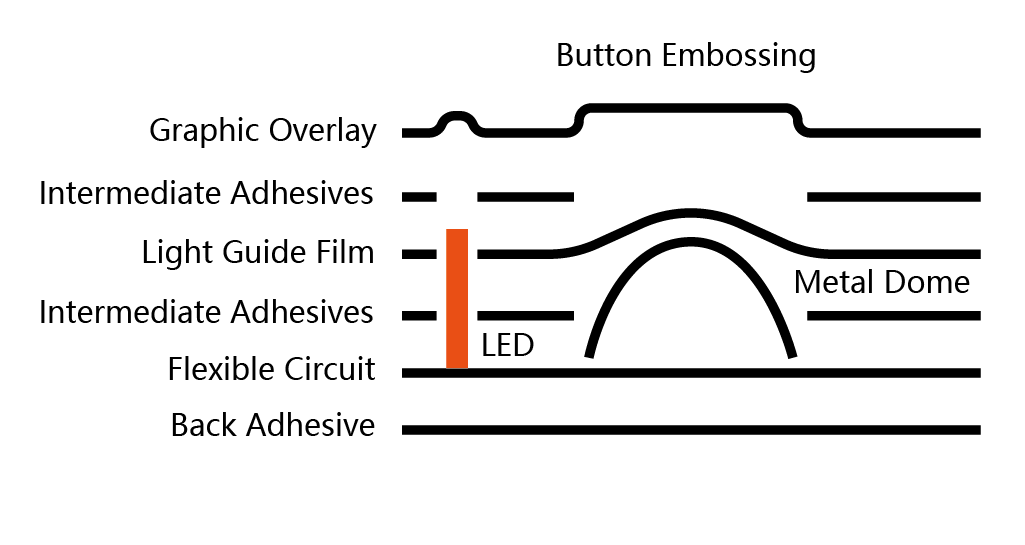The Manufacturing Process Behind Membrane Layer Switch: What You Required to Know
The manufacturing procedure behind membrane switches over combines careful layout, material option, and high quality control. It begins with comprehending the intricacies of membrane layer switch design and proceeds with numerous stages, consisting of material options and printing techniques. Each phase plays an important role in making certain functionality and sturdiness. The intricacies of layer construction and the extensive screening standards may disclose insights that are not immediately evident. What exists beyond these foundational aspects?
Recognizing Membrane Switch Over Design
Although membrane layer buttons may appear easy in the beginning glance, their design includes detailed considerations that guarantee performance and longevity. The design process begins with a comprehensive understanding of individual demands, including the interface's designated application and ecological aspects. Comfort designs is a vital component, as the format has to facilitate convenience of usage while ensuring that responsive responses fulfills customer expectations.Moreover, the layering of elements, such as graphic overlays, sticky layers, and conductive traces, should be precisely engineered. membrane switch. This layered arrangement not just influences the switch's responsiveness but likewise affects its durability. Interest is offered to the securing strategies utilized to safeguard against moisture and dirt, which can jeopardize performance. Additionally, layout factors to consider reach aesthetic appeals, where color design and aesthetic clearness enhance customer experience. Eventually, the design of membrane layer changes balances functionality, customer experience, and toughness, guaranteeing that they meet the needs of different applications effectively
Products Used in Membrane Layer Change Production
When choosing materials for membrane layer switch production, it is important to ponder both efficiency and resilience. The key materials consist of polyester and polycarbonate films, which give flexibility and toughness. These films are often coated with glue to ensure correct bonding to substrates. Conductive inks, commonly composed of silver or carbon, are critical for developing electric connections within the switch, permitting trusted operation.Additionally, a protective layer, such as a tough coat, is often related to enhance scrape resistance and long life. The choice of backing product, such as acrylic or foam, can substantially impact the button's responsive feel and general customer experience. Moreover, different ecological elements, consisting of temperature level and moisture, should assist product selection to ensure peak performance in certain applications. Eventually, the appropriate combination of materials adds to the membrane layer button's capability and lifespan, making informed choices vital for manufacturers.
The Printing Process: Creating Graphics and Text
The printing process in membrane switch manufacturing plays a significant role in producing high-grade graphics and message. Various visuals layout strategies are used to assure visual charm and performance, while cautious ink choice techniques are necessary for toughness and efficiency. Comprehending these components is basic for attaining ideal outcomes in membrane switch design.
Graphic Design Techniques
Graphic design strategies play an important duty in the printing process of membrane layer switches, as they specify exactly how graphics and text will ultimately show up on the end product. Efficient graphic design entails the calculated use of layouts, font styles, and shades to improve readability and aesthetic charm. Developers commonly utilize vector graphics for scalability, making certain that pictures remain sharp at numerous sizes. Furthermore, attention to contrast and placement is important, as it affects user communication and visual high quality. The unification of branding aspects, such as logo designs, should be taken care of with like preserve brand name honesty. Generally, thoughtful visuals design methods add considerably to the performance and attractiveness of membrane buttons, affecting customer experience and item performance.
Ink Choice Approaches
Picking the appropriate ink is necessary for attaining the preferred aesthetic quality and sturdiness in membrane layer button manufacturing. Various ink types are used, consisting of solvent-based, water-based, and UV-curable inks. Each kind provides unique attributes, such as versatility, bond, and resistance to environmental elements. Solvent-based inks are commonly preferred for their longevity and vivid colors, while water-based inks are a lot more eco-friendly however might have limitations in adhesion. UV-curable inks give fast curing and robust performance. Furthermore, color matching strategies guarantee that the chosen inks line up with style specs. Eventually, the choice of ink must consider aspects such as application approach, substrate compatibility, and end-use needs to accomplish remarkable results in membrane button graphics and message.
Layer Construction and Assembly

Product Choice Refine
A cautious option of products is necessary in the manufacturing procedure of membrane buttons, as it straight affects functionality and toughness. The primary materials utilized include polyester, polycarbonate, and numerous conductive inks. Polyester is typically favored for its superb resistance to chemicals and abrasion, making it suitable for extreme settings. Polycarbonate, on the other hand, offers exceptional quality and effect resistance, which is beneficial for applications calling for visibility and robustness. Conductive inks, typically composed of silver or carbon, are crucial for creating reliable electrical paths. In addition, the choice of glue products affects the general stability of the button - membrane switch. Evaluating elements such as environmental exposure, tactile feedback, and aesthetic demands overviews manufacturers in choosing the most effective materials for their certain applications
Layer Attachment Methods
Sticking layers in membrane switch building and construction is a vital process that ensures functionality and long life. Different bond methods are employed to safeguard excellent bonding i loved this between layers, which generally consist of the use of adhesives, warm, and stress. Pressure-sensitive adhesives (PSAs) are typically made use of for their simplicity of application and instant bonding capacities. In addition, thermal bonding techniques can be applied, where warmth is made use of to turn on adhesive buildings, securing a solid bond. The option of attachment approach greatly depends upon the materials involved and the details application demands of the membrane layer button. Appropriate positioning and consistent application of adhesives are necessary to prevent problems, securing the switch runs effectively throughout its intended lifespan.
Quality Control Steps
Guaranteeing high quality control throughout the layer construction and setting up of membrane layer switches is vital for preserving efficiency and reliability. This process generally includes several essential actions, consisting of detailed inspections at each stage of manufacturing. Producers make use of innovative testing techniques, such as peel examinations and adhesion analyses, to validate the integrity of layer bonds. In addition, visual examinations are conducted to identify any type of issues in printing or product incongruities. Environmental conditions, such as temperature level and moisture, are meticulously kept track of to guarantee perfect curing and adhesion. Regular calibration of devices aids maintain specific manufacturing criteria. By carrying out these quality assurance measures, makers can significantly decrease the danger of product failure, assuring that the last membrane changes meet the needed specs and client expectations.
Examining and Quality Assurance Actions

Advancements in Membrane Switch Over Modern Technology
As innovations in modern technology continue to progress, membrane layer buttons are benefiting from innovative growths that enhance their functionality and customer experience. One noteworthy technology is the combination of capacitive touch technology, which permits more responsive and user-friendly interface. This shift not only improves aesthetics yet additionally minimizes mechanical wear and tear, expanding the life expectancy of the switches.Additionally, innovations in graphic overlay products have resulted in enhanced longevity and resistance to environmental elements such as wetness and UV light. These products currently supply improved clearness and illumination, more boosting the visual appeal.Furthermore, the unification of clever innovation is transforming membrane layer changes right into interactive control panels, allowing connectivity with IoT gadgets. This connection promotes a smooth individual experience, paving the method for applications in various sectors, from health care to consumer electronics. Collectively, these innovations position membrane layer changes as essential elements in contemporary device design.
Often Asked Inquiries
Exactly how Lengthy Does the Membrane Layer Switch Manufacturing Refine Take?
The duration of the membrane layer button manufacturing procedure can differ considerably. Variables such as complexity, materials made use of, and production quantity influence timelines, with typical production ranging from a few days to several weeks for conclusion.
What Are the Usual Applications for Membrane Buttons?
Membrane layer switches are generally used in navigate to this website various markets, including vehicle controls, house appliances, medical gadgets, and customer electronic devices (membrane switch). Their versatility and toughness make them excellent for applications requiring straightforward user interfaces and dependable efficiency in varied atmospheres
Can Membrane Switches Over Be Custom-made for Specific Needs?

What Is the Life-span of a Regular Membrane Layer Change?
The life expectancy of a typical membrane layer switch varies, however typically, it ranges from 1 to 5 million cycles. Aspects such as usage, atmosphere, and worldly high quality significantly influence resilience and total efficiency with time.

Are Membrane Changes Environmentally Friendly?
The ecological friendliness of membrane layer switches varies. Some materials utilized may not be recyclable, while others can be green. The general effect depends on making techniques and materials, demanding mindful factor to consider throughout option and disposal. The production procedure behind membrane switches combines careful design, product option, and quality control. It starts with understanding the intricacies of membrane button style and advances with numerous phases, consisting of material choices and printing strategies. When picking products for membrane switch manufacturing, it is essential to contemplate both efficiency and toughness. A cautious selection of products is essential in the production process of membrane switches, as it straight affects functionality and resilience. The selection of bond method greatly depends on the materials involved and the details application demands of the membrane layer switch.